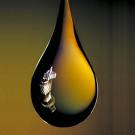Researchers at Bristol University's School of Chemistry have used light to separate complex chemical mixtures.
One possible application is to recover high value products and catalytic nanoparticles from reaction mixtures.
In the process, light-sensitive surfactants were added to microemulsions. When UV light was shone onto the mixtures, the surfactants caused the oil and water phases in the emulsions to separate.
Previously researchers have relied on heat, pH changes or salt addition to separate the phases in microemulsions. The new method does not change the chemical composition of the microemulsion or use as much energy as heat-induced separation.
Prof Julian Eastoe, of Bristol University, said: 'These separations are reversible. A sample can be cycled between dispersed and separated states using only light. The research shows the dream of light-triggered colloids is becoming reality.'
The new method could be used in light-activated release and delivery systems for pharmaceuticals and agrochemicals. But the next task is to develop photosensitive surfactants that are cheap, safe and environmentally friendly.

When UV light is shined on the emulsion, the surfactant causes the oil and water phases to separate




Mandate sets 2030 date for use of sustainable aviation fuel
I do hope this doesn't cause costs to UK aviation to rise and lose business to those staying on fossil fuels.